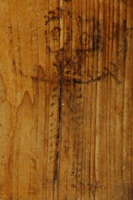
 |
|
 |
| Home |
| Background |
| Curriculum |
| The Schoolhouse |
| Teachers & Students |
| Apprenticeships |
| Artifacts |
| The Gymnasium |
| UM Papyrology Home |
| References |
| Credits |

Schools as we know them didn't really
exist in ancient Egypt. When you think of a school, you probably think
of a complex of buildings, including classrooms, a cafeteria, an auditorium,
and a playground. Most schools in the United States are public schools,
built and maintained at public expense. This wasn't the case in antiquity! |
||
| The
Building |
||
| The early years of a student’s
education were usually spent with a single teacher who would teach
them basic reading and writing. School wasn’t free- each student
had to pay a yearly sum for the teacher’s service. It was up
to the teacher to decide where to hold class- some used their homes,
some rented rooms (if they had enough students to cover the expense),
and some just sat outside under the shade of a tree! In the villages, where teachers would have fewer students and couldn’t charge very much, classes were fairly informal, but in the towns we hear of actual schools. The papyri refer to ‘didaskaleia’, which means ‘places for teaching’. These were probably rented out by the teachers, and since some wealthy children from the villages were sent to the towns for a better education, they may also have had dormitories. Most students were done after their elementary education. A few well-to-do children went on to secondary education. Generally, these schools were in the towns and cities. Often, teachers would still use their homes as classrooms, but we know that some rented bigger places as well. One surviving papyrus, a letter in which a young man named Sarapion asks his friend Ptolemaios for help with his geometry, is addressed to the ‘grammatodidaskaleion’ of Melankomas. This word means ‘place for teaching grammar’, and it must have been well-known enough for the letter-carrier to know where it was. |
||
|
Doodling in class? Click here to see it. |
Goofing
Off |
Discipline |
| Play was as important
a part of childhood for young men and women in Graeco-Roman Egypt
as it is for children today. After lessons, students were often dismissed
for sports, which were considered an important part of development
for a well-rounded individual. When students were bored, they found ways to amuse themselves. An example of a shift of focus to provide relief from a boring lesson might be found on the wooden tablet linked below. One had to be careful, however, not to get caught, since punishment could be severe... |
One unfortunate aspect of Egypt's educational system was that students were regularly punished for disobedience. Most often, they were caned or whipped when they misbehaved. To make matters worse, sometimes they were beaten just for having difficulties with the course material- if they couldn't recite poetry correctly, or couldn't write their lessons accurately, they could face punishment. | |